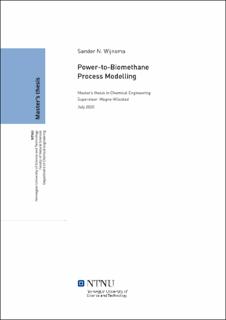| dc.description.abstract | In this project the Power-to-Methane process will be designed and evaluated that consists of an alkaline electrolyser, multi-tubular methanation reactor and polyimide membrane. The feed gas CO2 is modelled in accordance with specifications given from the amine absorber located at the Biokraft plant in Skogn and the product is required to be of liquefaction quality. By applying the Power-to-Methane process the productivity of the plant can be increased while decreasing the CO2 emissions of the plant.
The process has been designed and evaluated in HYSYS V10. An advanced MATLAB (R2019a) code for the multi-tubular methanation reactor was connected by using a CAPE-OPEN unit operation. Such an advanced way of modelling the methanation reactor was required because of a high runaway temperature from the highly exothermic methanation reaction. As a consequence of this high runaway temperature, the catalyst can be deactivated which is strongly unwanted.
The design work and results are in accordance with similar work in literature. The Power-to-Methane process is rather novel and has become more interesting in industry over the last years. The process becomes more novel in this project since the thought is to include the liquefaction step to produce bio-LNG from the high quality biomethane that is produced.
The results of the model suggest that the Power-to-Methane process is favoured at high operating pressure. However, this results in a higher reaction rate which in turn increases the temperature runaway. To solve this challenge, it is possible to reduce the dilution factor to oppose the reaction rate. This suggests that there must be an optimum point at which the pressure can be maximised while maintaining a stable process.
The alkaline electrolyser for the production of hydrogen has a high investment cost and electrical energy demand. Therefore, it is the main contributor to the cost for the Power-to-Methane process. In fact, the electrical energy demand is found to be so high, that the cost for producing methane are almost as high as the production cost of hydrogen making the process not profitable for now. However, the electricity cost and investment cost electrolyser are expected to decrease in the next years before the plant is expected to be build. | |
